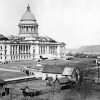calsfoundation@cals.org
Folkloric Relocations of the Arkansas State Capital
There are a few staples of local history and folklore in the state of Arkansas repeated widely throughout numerous different communities. One such oft-repeated phrase is “Hernando de Soto went through here,” which many communities were able to claim more authoritatively before more modern and scientific reconstructions of the route of the de Soto expedition narrowed down the possibilities. Other stories deal with the location of Indian mounds or villages in the area before white settlement, or the presence of noted outlaw Jesse James, or a visit from Civil War guerrilla William Quantrill. Also among the legends presented in many local histories is that any number of towns were almost designated the state capital.
Much of the confusion as to possible alternate designations of the state capital results from the complex politics of the territorial period. When Arkansas was designated a federal territory in 1819, the capital was placed at Arkansas Post (Arkansas County). However, state legislators soon began to seek out a place more centrally located in the territory. Among the contenders were Cadron (in present-day Faulkner County but then in Pulaski County), which petitioned the U.S. House of Representatives for the honor, and Little Rock (Pulaski County). Cadron was designated the seat of Pulaski County in 1820. On February 22, 1820, a bill was introduced to move the territorial seat of government from Arkansas Post to Cadron, but this bill was only approved with an amendment that changed Cadron to Little Rock. In October 1820, the state legislature approved $1,400 to build the county jail and courthouse at Cadron; that same month, Governor James Miller signed a law firmly designating Little Rock as the territorial capital. In October 1821, the territorial legislature relocated the county government to Little Rock; money for building any administrative infrastructure at Cadron had never been spent, although county clerk Alexander H. Rennick had his office there briefly. (Governor Miller had purchased land in the Crystal Hill area of Pulaski County in March 1821; some historians have suggested that he intended to profit from the sale of this land to the government for a location of the capital.)
Other self-designations by various communities as to their status as “almost the state capital” are a little more spurious. According to local history, Collegeville (Saline County), which was founded by Ezra Owen, was mentioned as a possible capital location based upon its placement along the Southwest Trail near the center of the state. Local folklore holds that what is now called Old Austin (Lonoke County), an early settlement in the state, missed being the capital by one vote; the origins of this may lie in Old Austin narrowly missing out on being designated the site for what is now Ouachita Baptist University. Similar stories abound regarding other communities that purportedly missed being the state capital “by one vote,” including Roseville (Logan County), Tulip (Dallas County), and Rockport (Hot Spring County)—the latter also claiming a visit from Hernando de Soto. According various sources, Norristown (Pope County) either competed or tied with Little Rock for the state capital early on or failed to become the capital by a margin of two votes when the state legislature voted upon the issue in 1842; both of these assertions are false, for Norristown was not founded until about 1829, and the state legislature never considered relocating the capital before the Civil War. In the late 1850s, Des Arc (Prairie County) was engaged in a heated rivalry with Little Rock over the course of a railroad stretching from Memphis, Tennessee, to Fort Smith (Sebastian County). Perhaps to give their case more weight, on November 29, 1858, the aldermen of Des Arc adopted a resolution to move the state capital from Little Rock to Des Arc. Nothing resulted from this, and Little Rock succeeded in getting the railroad, though it was never built due to the Civil War.
The state’s Confederate government relocated the capital away from Little Rock twice during the course of the Civil War. From May 6 to July 14, 1862, the city of Hot Springs (Garland County) served as the Confederate capital on account of fears that Union forces were soon to advance upon Little Rock. With the fall of Little Rock in September 1863, the Confederate government moved again, this time to Washington (Hempstead County), where it resided until war’s end, though carrying out little official business. Union forces reconstituted a competing government in Little Rock. When Union forces threatened Washington in 1864, Governor Harris Flanagin ordered the state records relocated to Rondo (Miller County) for a time, leading some to argue that, for all intents and purposes, that town served briefly as the state’s Confederate capital.
With the end of the Civil War, state administration was consolidated in Little Rock once more. Since that time, there has been no discussion of relocating the state capital elsewhere.
For additional information:
Anthony, Isabel, ed. Garland County, Arkansas: Our History and Heritage. Hot Springs, AR: Garland County Historical Society, 2009.
Gravely, Ernestine. “Early Twin Cities of Arkansas: Dardanelle and Norristown.” Arkansas Historical Quarterly 10 (Summer 1951): 177–181.
Medearis, Mary. Washington, Arkansas: History on the Southwest Trail. Hope, AR: Etter Printing Company, 1976.
Ross, Margaret Smith. “Cadron: An Early Town That Failed.” Arkansas Historical Quarterly 16 (Spring 1957): 3–27.
Worley, Ted R. Early History of Des Arc and Its People. Des Arc, AR: White River Journal, 1957.
Staff of the CALS Encyclopedia of Arkansas


 Confederate State Capitol
Confederate State Capitol  James Miller
James Miller 



Comments
No comments on this entry yet.